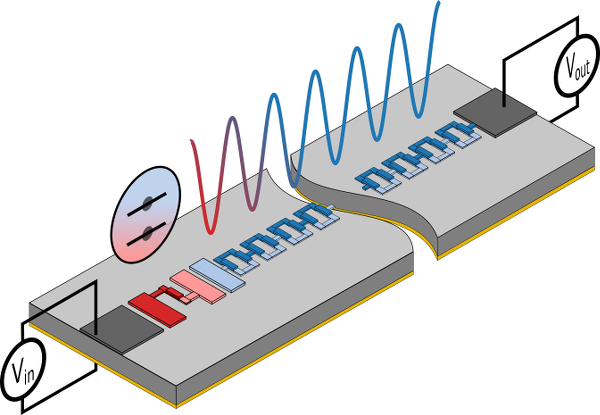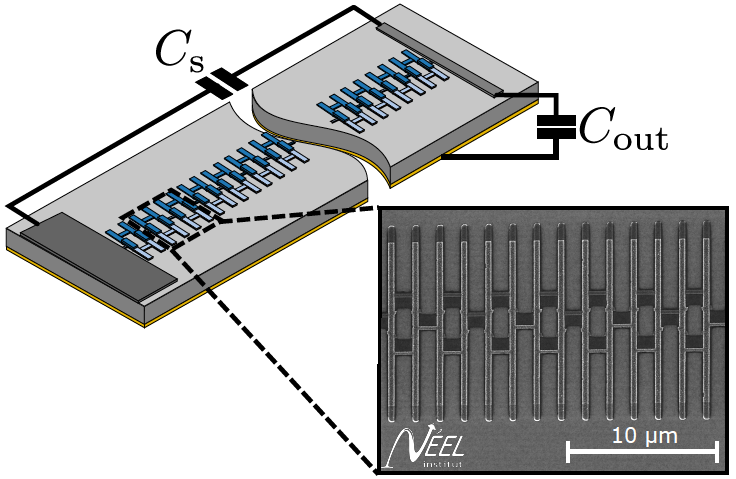Research Topics
Many-body quantum optics with superconducting circuits
The use of superconducting circuits as building blocks for studying light matter interactions at the fundamental level was introduced more than a decade ago and is named Circuit Quantum ElectroDynamics (circuitQED). With this project we want to push these ideas to the next level and build circuits to explore many-body quantum optics.
The key element of these circuits is the Josephson junction, two superconductors separated by a thin insulating barrier. Depending on their size, such junctions can be operated in the quantum regime (size ~ hundreds of nanometers by hundreds of nanometers) or in the classical regime (size ~ several micrometers by several micrometers). In the quantum regime, thanks to their huge non linear inductance they can be used for fabricating quantum two level systems or quantum bits (qubits). In the classical regime, they provide very large and tunable inductances. By making arrays of such classical junctions we can obtain a new type of metamaterials: high impedance and tunable transmission lines.

In this work we are interested in studying a qubit strongly coupled to such a metamaterial, which contains many electromagnetic degrees of freedom (called plasma modes). By tailoring the properties of this metamaterial (more specifically its characteristic impedance), we can enhance the qubit-plasma modes coupling up to the ultra-strong coupling regime.
We couple the qubit (in red on the figure) via coupling capacitors to an array of 4700 Josephson junctions (in blue). We probe the system via microwave transmission measurements. We obtain a strong hybridization of the qubit levels with several modes of the environment and thus demonstrate an on-chip many-body system.
Related Publications:
Observation of quantum many-body effects due to zero point fluctuations in superconducting circuits
S. Leger, J. Puertas Martínez, K. Bharadwaj, R. Dassonneville, J. Delaforce, F. Foroughi, V. Milchakov, L. Planat, O. Buisson, C. Naud, W. Hasch-Guichard, S. Florens, I. Snyman, and N. Roch,
Nature Communications 10, 5259 (2019), Arxiv | Nat. Commun.
A tunable Josephson platform to explore many-body quantum optics in circuit-QED
J. Puertas Martinez, S. Leger, N. Gheereart, R. Dassonneville, L. Planat, F. Foroughi, Y. Krupko, O. Buisson, C. Naud, W. Guichard, S. Florens, I. Snyman, N. Roch,
npj Quantum Information 5, 19 (2019), Arxiv | npj Quantum Information
See also editorial from Audrey Cottet: Superconducting quantum bits with artificial damping tackle the many body problem
Particle production in a waveguide ultra-strongly coupled to a qubit
N. Gheeraert, X. H. H. Zhang, S. Bera, N. Roch, H. U. Baranger and S. Florens,
Physical Review A 98, 043816 (2018), Arxiv | Phys. Rev. A
Stabilizing Spin Coherence Through Environmental Entanglement in Strongly Dissipative Quantum Systems
S. Bera, S. Florens, H. U. Baranger, N. Roch, A. Nazir, and A. W. Chin,
Physical Review B 89, 121108(R) (2014), Arxiv | Phys. Rev. B
Near quantum limited amplifiers
During the last decade, it has been demonstrated that superconducting Josephson circuits behave as quantum bits and are very well suited to realize advanced quantum mechanical experiments. These circuits appear as artificial atoms whose properties are defined by their electronic characteristics (capacitance, inductance and tunnel barrier).
Moreover, given their mesoscopic size, these quantum bits couple very strongly to electromagnetic radiations in the microwave range. Thus, it is now possible to perform quantum optics experiments using microwave photons and to unravel light-matter interactions using circuits. This field is dubbed circuit-QED (Quantum Electro-Dynamics).

Measuring these microwave photons with very high quantum efficiency remains a tremendous challenge, since the energy conveyed by one single microwave photon is hundreds thousand times smaller than the one of usual optical photons. Yet signals at the single-photon level can be measured using Josephson parametric amplifiers.
In our team we are now using superconducting metamaterials (see figure) to engineer the next generation of parametric amplifiers. These new devices allow us to explore the quantum limits of amplification as well as to perform quantum optics experiments.
Related Publications:
A photonic crystal Josephson traveling wave parametric amplifier
L. Planat, A. Ranadive, R. Dassonneville, J. Puertas Martínez, S. Leger, C. Naud, O. Buisson, W. Hasch-Guichard, D. M. Basko, and N. Roch,
Physical Review X 10, 021021 (2020) Arxiv | Phys. Rev. X
See also Physics Synopis: A Simple Solution for Microwave Amplification and CNRS la lettre innovation: Un amplificateur quantique pour la lecture des bits quantiques.
Non-degenerate parametric amplifiers based on dispersion engineered Josephson junction arrays
P. Winkel, I. Takmakov, D. Rieger, L. Planat, W. Hasch-Guichard, L. Grünhaupt, N. Maleeva, F. Foroughi, F. Henriques, K. Borisov, J. Ferrero, A. V. Ustinov, W. Wernsdorfer, N. Roch, and I. M. Pop,
Physical Review Applied 13, 024015 (2020), Arxiv | Phys. Rev. Applied
Fabrication and characterization of aluminum SQUID transmission lines
L. Planat, E. Al-Tavil, J. Puertas Martínez, R. Dassonneville, F. Foroughi, S. Leger, K. Bharadwaj, J. Delaforce, V. Milchakov, C. Naud, O. Buisson, W. Hasch-Guichard, and N. Roch,
Physical Review Applied 12, 064017 (2019), Arxiv | Phys. Rev. Applied
Understanding the saturation power of Josephson Parametric Amplifiers made from SQUIDs arrays
L. Planat, R. Dassonneville, J. Puertas Martínez, F. Foroughi, O. Buisson, W. Hasch-Guichard, C. Naud, R. Vijay, K. Murch, and N. Roch,
Physical Review Applied 11, 034014 (2019), Arxiv | Phys. Rev. Applied
Widely tunable, nondegenerate three-wave mixing microwave device operating near the quantum limit
N. Roch, E. Flurin, F. Nguyen, P. Morfin, P. Campagne-Ibarcq, M. Devoret, and B. Huard
Physical Review Letters 108, 147701, (2012), Arxiv | Phys. Rev. Lett.



